* 1.13" of precipitation expected from Tuesday afternoon through Wednesday afternoon (vast majority should fall as rain).
* Another storm arrives with more (rain) showers Friday night into Saturday evening; next Sunday appears to be the drier, nicer day for outdoor plans.
* A pattern in Texas' wildfires?
* Oklahoma drier now than Dust Bowl Year of 1930s.

Stunning Easter. Yesterday was spring the way it was probably meant to be in Minnesota - low 60s, no humidity, a gentle breeze. I lost count of the number of cyclists and convertibles. Finally.

No Need To Water Anytime Soon. The NAM model prints out close to 1" of rain tomorrow and Tuesday night, heaviest amounts south/west of the Twin Cities, where some 1.5 to 2" rainfall amounts are possible. Very little rain will fall north of Brainerd and Lake Mille Lacs.
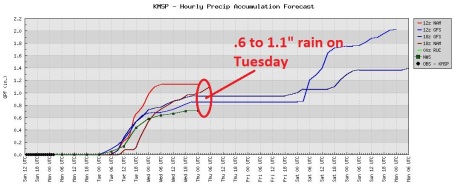
Dust Off The Umbrella. The models are in fairly good agreement: it's going to rain tomorrow. A lot. I suspect most of us will see at least .5 to .75" rain before the storm moves away early Wednesday. Tomorrow should be the wettest day of the week.
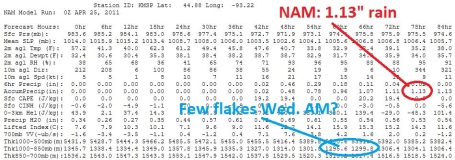
Latest Numbers. The 00z NAM data still prints out over 1" of precipitation. Although 98-99% of that will fall as rain, the lowest mile of the atmosphere may be marginally cold enough for a few wet snowflakes to mix in Wednesday morning. I know - but I can't print that.
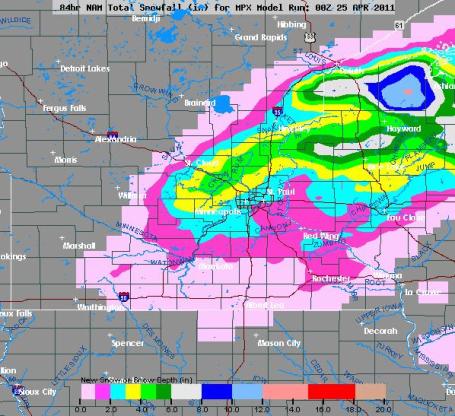
Make It Stop. Models may be exaggerating the risk of slushy snow at the tail-end of the storm Wednesday, but I wouldn't rule anything out at this point. Let's see a few more model runs, but know that rain may mix with a little wet snow Wednesday morning with a potential for a couple inches of slush, especially north/west of the metro. With temperatures above 32 I expect roads to stay wet. I can't believe I have to type these words during the last week of April.
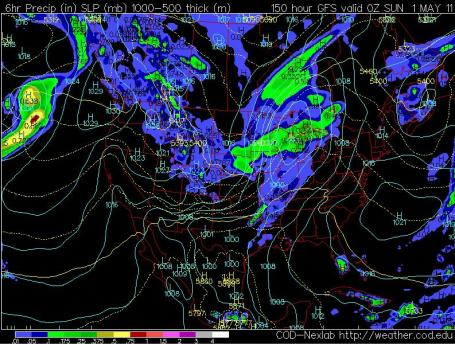
Soggy Saturday Blues. What is it about rain on Saturdays? The latest GFS model shows a vigorous storm winding up over the Great Lakes by Saturday, wrap-around "backlash" showers, sprinkles, and a cool northwest wind translating into a rather foul Saturday as temperatures fall through the 50s. Sunday looks like the better day right now.
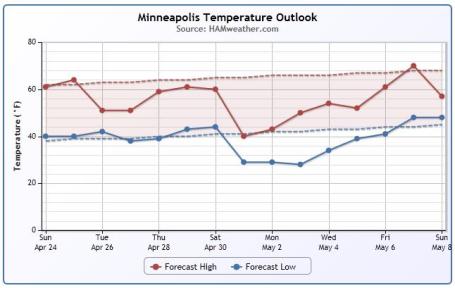
Closer To Average. Highs reach the low to mid 60s today, followed by a temperature relapse tomorrow, and a taste of March-like weather late Saturday into Sunday. Some of the long-range models are hinting at 60s, even a few 70s, by May 6-8.
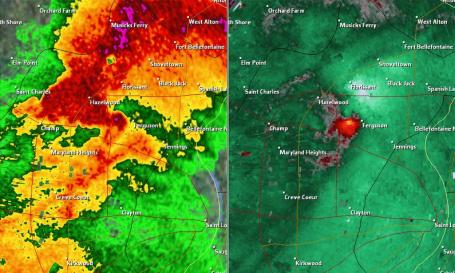
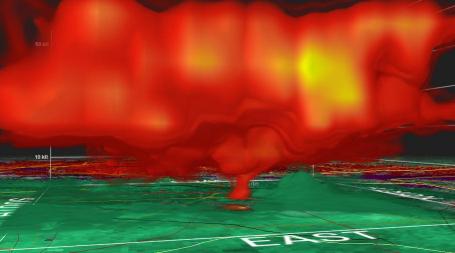
Tracking The St. Louis Tornado. Click here to see an amazing thread from Medialine.com, including Doppler radar images from last Friday, when an EF-4 strength tornado was raging across the northwestern suburbs of St. Louis. The image above (right) shows a strong velocity "couplet", evidence of violent rotation. The image below is a 3-D visualization of SRV, or storm relative velocity, clearly showing rotation reaching the ground (using a software program called GR2 Analyst - which you can run on your PC for a one-time fee of $250). If you're a storm spotter/chaser or weather enthusiast it's worth every penny.
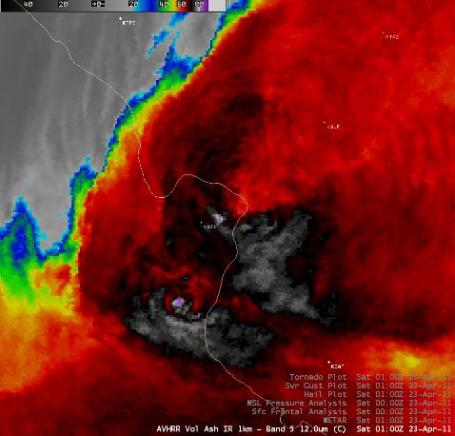
EF-4 Tornado Strikes The St. Louis Area. The University of Wisconsin CIMSS blog has an interesting post focusing on the use of high-resolution satellite imagery to predict and track tornadoes: "AWIPS images of GOES-13 10.7 µm IR data (above; click image to play animation) showed a large line of severe thunderstorms that moved eastward across the middle Mississippi River Valley region during the evening of 22 April 2011. This storm produced a significant number of large hail, damaging wind, and tornado reports (including one that did damage to the St. Louis airport). The initial storm damage survey has found EF-4 damage in the northern St. Louis county area. A 1-km resolution POES AVHRR image very close to the time that the tornado was moving through the St. Louis area is shown below, with an overlay of the SPC hail, damaging winds, and tornado reports. Though the time stamp of the AWIPS image was “01:00 UTC”, the actual time that the NOAA-16 satellite was making its overpass of that region was about 01:12 UTC. Note that the storm exhibited a very well-defined “enhanced-v” signature near St. Louis (with a minimum cloud top IR brightness temperature of -83º C) — this enhanced-v IR storm top signature is often observed with areas of strong convection that are producing (or are about to produce) either large hail, damaging winds, or tornadoes."

No Deaths In St. Louis Tornado Called A Miracle. An EF-4 hits a heavily populated suburb of a major metropolitan area (and an airport close to rush hour), and there are NO deaths? A 20+ minute lead time was largely responsible - the National Weather Service did a remarkable job, as did local TV/radio stations in getting the word out. More from the AP: "BRIDGETON, Mo. (AP) -- The St. Louis area's most powerful tornado in 44 years rips into an airport and through a densely populated suburban area, destroying up to 100 homes, shattering hundreds of panes of glass at the main terminal and blowing a shuttle bus on top of a roof. Yet no one is killed, or even seriously hurt, and the airport reopens less than 24 hours later. How? Early warnings, good timing and common sense all helped prevent a tragedy Friday night. But on Easter Sunday, many of those cleaning up the mess also thanked a higher power. "I don't know why God decided to spare our lives but I'm thankful for it," Joni Bellinger, children's minister at hard-hit Ferguson Christian Church, said Sunday."
* Baseball to grapefruit-size hail preceded the EF-4 tornado. The example above from yfrog.com.
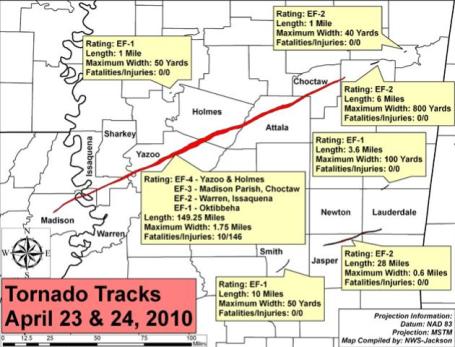
Anniversary Of The Yazoo City Tornadoes. Two tornadoes on two consecutive days? Yazoo City, Mississippi was hit very hard one year ago. The tornadoes claimed 10 lives, injuring 146 residents. More details from the National Weather Service here.
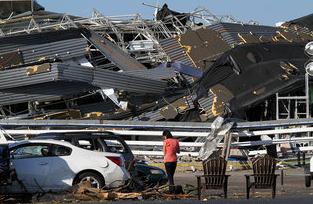
Stores Prepped, Ready To Weather Emergencies. In the aftermath of the North Carolina tornado that leveled a Lowe's department store, charlotteobserver.com has details on how retailers are preparing themselves (and their customers) for the next round of extreme weather: "In retailers' disaster planning, as in Boy Scouts, the motto is "Be prepared." A devastating tornado last weekend destroyed the Lowe's in Sanford, about 40 miles southwest of Raleigh, but no employees or customers were injured as the twister tore off the building's roof and smashed walls. Officials - including President Barack Obama - credited the store's manager and staff with getting everyone to a safe room in the back. But the manager, Mike Hollowell, attributed much of his success to the store's disaster preparedness plans and sales associates knowing what to do. Other experts and locally based retailers say he's right. Plans are essential, and the stores say they spend time practicing steps for scenarios they hope their employees don't have to use."

Out Of Thick Air. "Harvesting" fog to produce clean drinking water in Africa? A novel idea, documented by MIT New: "In the arid Namib Desert on the west coast of Africa, one type of beetle has found a distinctive way of surviving. When the morning fog rolls in, the Stenocara gracilipes species, also known as the Namib Beetle, collects water droplets on its bumpy back, then lets the moisture roll down into its mouth, allowing it to drink in an area devoid of flowing water. What nature has developed, Shreerang Chhatre wants to refine, to help the world’s poor. Chhatre is an engineer and aspiring entrepreneur at MIT who works on fog harvesting, the deployment of devices that, like the beetle, attract water droplets and corral the runoff. This way, poor villagers could collect clean water near their homes, instead of spending hours carrying water from distant wells or streams. In pursuing the technical and financial sides of his project, Chhatre is simultaneously a doctoral candidate in chemical engineering at MIT; an MBA student at the MIT Sloan School of Management; and a fellow at MIT’s Legatum Center for Development and Entrepreneurship."

Behind The Rising Cost Of Food. The New York Times has a good explanation about why it's costing more every time you head down too Cub or Rainbow Foods. One culprit: the rising cost of gasoline - petroleum products involved in every part of the food production process: from fertilizers and pesticides to transportation: "The plate has always been a great fortifier. Soup to heal, stew to comfort, escape delivered in a good piece of chocolate. But events both at home and internationally are conspiring to shake the confidence of eaters. Global famine, war and disaster are no longer so easy to keep from the table. Let’s consider, for a moment, the chocolate Easter bunny. The price of chocolate has been rising. Hershey’s recently said it had increased the cost of its products by almost 10 percent. The cost of fuel is a culprit, but so are the politics of the Ivory Coast, which supplies more cocoa beans to the word than any other country. While Laurent Gbagbo tried to hold onto his presidency, his rival cut off export of the cocoa crop, and prices in the United States hit a 32-year high. It’s not just chocolate. Coffee, that other daily solace, is rising to levels that might finally slow the specialty coffee juggernaut. Demand for quality beans is growing around the globe, but drought — possibly the result of climate change — is limiting supply. But say you can live without a $4 cappuccino or even a chocolate bunny. Prices for the most basic staples are also going up. Domestically, wholesale food prices rose 3.9 percent in February, the largest increase on record for one month since 1974."

Show Us The Data (It's Our's, After All). I don't think any of us realize how much our private data is being mined today online and on mobile devices. Many "free" services like Twitter and Facebook actually come at a cost - we give up our privacy in return for the ability to use these services. Although these services insist that no one user is being singled out, there is growing concern about what information is being harvested, and how it's ultimately being used to tailor advertising and other online pitches. The New York Times has the story: “NO one knows what I like better than I do.” This statement may seem self-evident, but the revolution in information technology has created a growing list of exceptions. Your grocery store knows what you like to eat and can probably make educated guesses about other foods you might enjoy. Your wireless carrier knows whom you call, and your phone may know where you’ve been. And your search engine can finish many of your thoughts before you are even done typing them. Companies are accumulating vast amounts of information about your likes and dislikes. But they are doing this not only because you’re interesting. The more they know, the more money they can make. The collection and dissemination of this information raises a host of privacy issues, of course, and the bipartisan team of Senators John Kerry and John McCain has proposed what it is calling the Commercial Privacy Bill of Rights to deal with many of them. Protecting our privacy is important, but the senators’ approach doesn’t tackle a broader issue: It doesn’t include the right to access data about ourselves. Not only should our data be secure; it should also be available for us to use for our own purposes. After all, it is our data."

How To Unmask The Internet's Vilest Characters. On the Internet everyone can be anonymous, which can be a good thing, or a true dilemma. The saying "the Internet never forgets" has merit, according to an expose in the N.Y. Times: "In June 2009, Lani (a nickname) got a Facebook message from a stranger alerting her to nude photos of herself that had been posted on a Web site called Private Voyeur — along with her name, her workplace and the city she lives in. The post, titled “Jap Slut,” was published anonymously by someone who used a proper noun followed by numbers as an Internet handle. Lani went to the police. She suspected that the poster was an ex-boyfriend who, she says, threatened to kill himself if she didn’t pose for naked photographs toward the end of their abusive relationship. According to Lani, when the police questioned her ex-boyfriend, he said that he had distributed the photos among his friends but that he wasn’t the one who put them on the Web. The police then told Lani they couldn’t help her, so she contacted Private Voyeur, which agreed to take the post down. A few months later, though, a new post appeared, with the same photographs and the same information identifying her. You might think that the legal system offers an easy solution to problems like these — but it doesn’t. According to free-speech advocates, there’s a good reason for that: Stopping trolls, which is the term used for those who abuse the privilege of the Web’s anonymous open mike, would mean choking off other critics, which obviously has undemocratic implications. After all, anonymity is a trusted tool of dissidents and whistle-blowers."
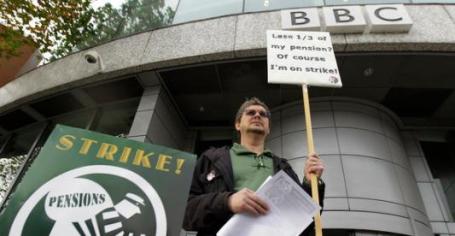
BBC, Under Criticism, Struggles To Tighten Its Belt. Established, legacy media is struggling to find new business models in an always-on, 24/7 digital world, where readers want their news on any device, and free, if possible. The problem? Trading print dollars for Internet nickels and dimes; monetizing content via advertising on the web, tablets and smart phones isn't compensating for the dollars lost from declining (print) properties, and even the venerable BBC is feeling the pain, according to a story in the New York Times: "DAVID CAMERON, the British prime minister, was in Brussels meeting the press last October when he took a few moments to make fun of the British Broadcasting Corporation. “Good to see that costs are being controlled everywhere,” Mr. Cameron said as he directed a mocking glance at three BBC correspondents, each from a different BBC program, covering his news conference. The implication: Considering that the BBC has agreed to freeze most of its public funding for six years, effectively sentencing itself to a 16 percent budget cut through 2017, it surely could have looked harder at its staffing needs for the event. “We’re all in this together,” Mr. Cameron said sarcastically, reciting his government’s favorite austerity slogan, and then added, “including, deliciously, the BBC.”

The Sad Beautiful Fact That We're All Going To Miss Almost Everything. It's an impossible (information) treadmill we're all on. We read magazines, newspapers, scour the Internet, get real-time tweets, and yet we can never truly get our arms around what's REALLY happening. NPR has the story: "The vast majority of the world's books, music, films, television and art, you will never see. It's just numbers. Consider books alone. Let's say you read two a week, and sometimes you take on a long one that takes you a whole week. That's quite a brisk pace for the average person. That lets you finish, let's say, 100 books a year. If we assume you start now, and you're 15, and you are willing to continue at this pace until you're 80. That's 6,500 books, which really sounds like a lot. Let's do you another favor: Let's further assume you limit yourself to books from the last, say, 250 years. Nothing before 1761. This cuts out giant, enormous swaths of literature, of course, but we'll assume you're willing to write off thousands of years of writing in an effort to be reasonably well-read. Of course, by the time you're 80, there will be 65 more years of new books, so by then, you're dealing with 315 years of books, which allows you to read about 20 books from each year. You'll have to break down your 20 books each year between fiction and nonfiction – you have to cover history, philosophy, essays, diaries, science, religion, science fiction, westerns, political theory ... I hope you weren't planning to go out very much."


Memorable Easter Sunday. Under a brilliant sun the mercury hit 61 at St. Cloud and 62 in the Twin Cities. Check out the number of cities (above) all reporting the same afternoon high (61). A very popular number.

Flashback. This was the scene outside my window last Wednesday morning, a quick 1-2" of slush. A few people asked me about the forecast for this week. "Oh, just rain? Thank God". My sentiments exactly. By the way that's a Davis Pro 2 weather station in the back yard. I have some equipment from Davis and La Crosse Technology, which makes some terrific (and affordable) weather stations. And yes, there is an outside chance that a slushy accumulation could build up on lawns, fields and slow-moving robins Wednesday morning, especially north of the Twin Cities. Insert (ugh) here.
Paul's Conservation Minnesota Outlook for the Twin Cities and all of Minnesota:
TODAY: First (extended) outdoor lunch? Fading sun, still mild. Winds: E 10-15. High: 64
MONDAY NIGHT: Clouds increase. Low: 44
TUESDAY: Cloudy with rain developing by afternoon. High: 53
TUESDAY NIGHT: Rain, heavy at times. Low: 33
WEDNESDAY: Showers linger, possibly mixing with a little wet snow in the morning. Windy and raw. High: 42
THURSDAY: More sun, warming up again. Low: 37. High: 65
FRIDAY: Mild, dry much of day with some sun. Showers/T-storms may arrive Friday night. Low: 47. High: 66
SATURDAY: Showery rains taper by afternoon. Low: 51. High: 62
SUNDAY: Damp start, then slow clearing as winds diminish - probably the nicer day of the weekend. Low: 38. High: 58

Precious (Fleeting) Warmth
If you haven't glanced at a map lately we're pretty far north. Warm fronts often tire out before reaching our latitude, stalling somewhere over Iowa. They have all the fun down there. One benefit of our cool "stunted" spring this year: a lack of widespread severe weather. Iowa has already endured 49 tornadoes, 19 in Wisconsin. The national statistics are mind-boggling: so far 559 preliminary tornado reports in April; since the beginning of 2011 a total of 3,199 separate reports of large hail and 4,370 additional documented cases of damaging winds. Welcome to the United (Severe) States of America.
Friday's EF-4 tornado in St. Louis is being called the Good Friday Miracle. 750+ homes damaged or destroyed, part of the airport turned to rubble, and not one fatality or serious injury.
Soak up 60s today; a southern storm pushes nearly 1" of rain into town tomorrow. Believe it or not, rain may end as a little slushy snow Wednesday morning. I know - this is getting really old. We dry out the latter half of the week - before an ill-timed storm arrives with storms Friday night and a jolt of rain Saturday. Winds on the backside of next weekend's (unusually intense, almost March-like) low pressure system may reach 30-40 mph. Is this any way to welcome May?
No shortage of things to talk about.
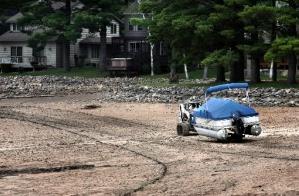
Report: Global Warming Will Toast Wisconsin. The Cap Times in Madison has the story: "Rising temperatures could have a devastating impact on Wisconsin's economy over the next decades, from a shrinkage in agricultural production to a meltdown of the American Birkebeiner ski marathon, according to a national report pegged to Earth Week. In fact, the report predicts winter temperatures here will rise 6 to 11 degrees Fahrenheit by the end of the century, with summer temps climbing 8 to 18 degrees higher. And because of its reliance on dairy farming, forestry and tourism, Wisconsin would face more significant effects than other states. By 2050, Wisconsin could face a loss of $6.2 billion in gross domestic product and nearly 39,000 jobs. The report was written by the American Security Project, a nonprofit, bipartisan public policy organization working on a range of issues. The group is chaired by former Sen. Gary Hart and includes both military and political leaders. Professor Don Waller, a botanist at UW-Madison, reviewed the report for Biz Beat and says it's accurate and raises some important questions. "We sometimes assume that building our economy and creating jobs demands that we sacrifice concerns for clean air and water and a healthier environment. That's a false dichotomy. In fact, it's downright wrong." Waller says."
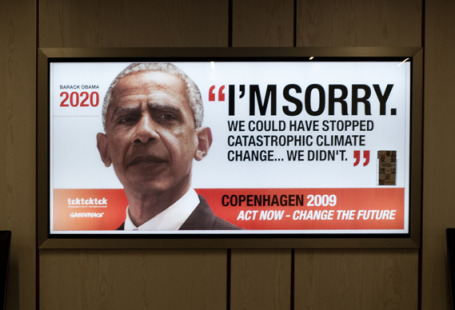
Former EPA Chief Says Ignorning Global Warming Would Be Costly. Here's a story from the St. Petersburg Times: "In these tough economic times, it's no surprise political leaders spend a lot less time talking about combating global warming than about the need to create jobs. But former Environmental Protection Agency Administrator Christine Todd Whitman says people should realize the implications of doing nothing. "A decision you can make is let's do nothing, it's too costly (to develop nuclear or solar). But understand you're going to pay a price down the road," Whitman said in a Political Connections interview airing today on Bay News 9 at 11 a.m. and 8 p.m. Whitman, a former governor of New Jersey, is a director of a bipartisan national security think tank called the American Security Project. Last week it released a study estimating that inaction on climate change by 2025 will cost Florida $27 billion, because of hurricane damage, real estate and tourism losses, and electricity consumption."
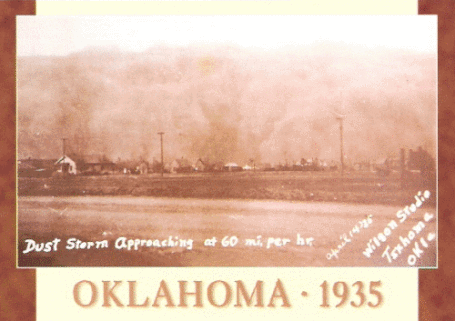
A Rerun Of The Dustbowl Days? Oklahoma Now Drier Than During The 1930s Dust Bowl. The wildfires racing across much of Texas may be a sign of things to come, according to new findings from USGS, reported in this story in Climate Progress: "Drier conditions projected to result from climate change in the Southwest will likely reduce perennial vegetation cover and result in increased dust storm activity in the future, according to a new study by scientists with the U.S. Geological Survey and the University of California, Los Angeles. The research team examined climate, vegetation and soil measurements collected over a 20-year period in Arches and Canyonlands National Parks in southeastern Utah. Long-term data indicated that perennial vegetation in grasslands and some shrublands declined with temperature increases. The study then used these soil and vegetation measurements in a model to project future wind erosion. That’s from the USGS news release for its Proceedings of the National Academy of Sciences study, “Responses of wind erosion to climate-induced vegetation changes on the Colorado Plateau.” Dust-Bowlification — combined with the impact on food insecurity of Dust-Bowlification (and other extreme events) — is, I believe, the biggest impact that climate change is likely to have on most people for most of this century (until sea level rise gets serious in the latter decades)."

Scientists See Pattern In Texas' Bad Wildfire Year. A fluke, blip, aberration - or a trend? The Sacramento Bee attempts to connect the dots with this story: "DALLAS -- Texas horizons have been red lately, but not from great sunsets. Wildfires have burned roughly 1.4 million acres and destroyed nearly 200 homes this year during one of the state's worst droughts and through its driest March. The manifold Texas calamities take on an apocalyptic, Mad Max quality, with exhausted firefighters attacking flames taller than they are and whole towns on alert for evacuation. Scientists say the immediate cause is a La Nina, a recurring, months-long pattern that blocks Texas' normal rains. But are the drought and fires also linked to climate change? Climate scientists say that question, though common whenever extreme weather arrives, is both unanswerable and misdirected. "By now, most people get that you can't attribute any single weather event on global warming," said John Nielsen-Gammon, the Texas state climatologist and a professor at Texas A&M University. Short-term weather, even over months, is too variable to show a trend. Track weather over years or decades, however, and trends emerge, but not always the ones people expect."
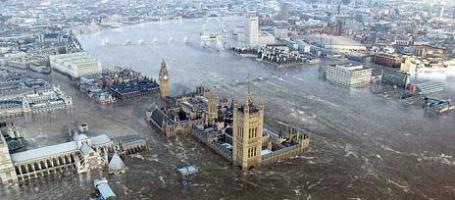
What Year Will Coastal Property Values Crash? Climateprogress.org has the post: "Coastal property values won’t wait to (permanently) fall until sea levels have actually risen 4 or 5 feet, as they almost certainly will by the end this century on our current CO2 emissions path (see Startling new sea level rise research: “Most likely” 0.8 to 2.0 meters by 2100 and Report from AGU meeting: One meter sea level rise by 2100 “very likely” even if warming stops?). Coastal property values will crash when a large fraction of the financial community and of opinion-makers — along with a smaller but substantial fraction of the public — realize that it is too late for us to stop 4 to 5 feet of SLR. And remember, if we don’t get on the sustainable sub-450-ppm path soon, then people will quickly come to understand that SLR won’t stop in 2100. Seas will continue rising post-2100 perhaps 10 to 20 inches a decade (or more) for centuries until we are ice free and seas are 250 feet higher. And that makes protecting most coastal cities very, very difficult and expensive. One of the points of my post “Is the global economy a Ponzi scheme and what comes next? Part 1,” of course, is that we haven’t hit that critical mass of knowledge yet. If we had, the world would be engaged in a massive, desperate effort to avert catastrophe. And so I pose the question in my talks: What year will coastal property values crash?

No comments:
Post a Comment